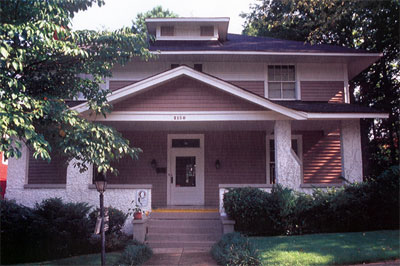This is the home in Birmingham, Alabama, where Samuel Ullman resided during his final two decades of life. “Granpa” Ullman lived here with his eldest daughter and her family, and he died in an upstairs bedroom. It was in the home’s dining room that, at approximately age seventy-eight, he wrote the poetic essay “Youth.” As you approach the home, you note the Craftsman-style elements of the house, such as the leaded-glass window above the front door and the rustic columns along the front porch.
Upon entering the Museum, one continues to see additional Craftsman details – including the home’s heart-of-pine flooring, its beautiful wood moldings around the walls and doorways, and the carved hearts above the mantle. Original light fixtures in the dining room and front bedroom of the home were designed to take advantage of the electricity that was newly available to citizens of Birmingham in 1907, when the house was constructed. The fixtures also contain “cups” to hold oil and wicks for the times when that “new” technology failed.
In the entryway or foyer, visitors observe a panel that honors the original donors who provided funds to purchase and renovate the house, a charcoal portrait of Mr. Ullman, and various translations of Ullman’s poem, Youth.” Most of these translations were provided by the Youth Association of Japan, an organization of more than a thousand Japanese businessmen and corporations that wished to share the inspiration contained in “Youth” with people around the world.
From the foyer, one moves into what was once the family’s parlor or living room. This room showcases family portraits including one of Samuel and his beloved wife, Emma, on their wedding day; another of their six surviving children; and one of an affectionate Ullman with his grandchildren. There is also a map of the world that traces Ullman’s journey as a boy from Germany to France; then, at age eleven to Port Gibson and Natchez, Mississippi; and, finally, to Birmingham, Alabama, as a man of forty-four.
As visitors move into the former dining room of the home, they will notice photographs, documents, and other artifacts that trace Ullman’s American journey chronologically, first as a young man assisting his father in a grocery business in Port Gibson, then as a soldier for the Confederacy. Ullman survived injuries he suffered during the Civil War, returned to Port Gibson, and soon moved to the larger city of Natchez, where he established a business, entered the civic and religious life of the community, and married and began a family. Ullman was respected and rewarded for his service to the community, particularly during periods when deadly “fevers” moved up the Mississippi River from New Orleans to Natchez. As many abandoned the unhealthy city, Ullman remained to run his and others’ businesses, to provide religious services for the temple congregation, and to serve as a civic leader. Ullman was elected a city alderman and was appointed to the city’s board of education. The black, as well as the white, community found him always impartial and fair, a rare attitude for that time and community.
Seeking improved economic circumstances for his family, Ullman moved to Birmingham, Alabama, in 1884. In this New South city, he established a hardware store, joined a small Reform congregation, and was immediately placed on Birmingham’s board of education. As chairman of the board, he gave critical support for creation of a high school for blacks in the city, one of the few such schools anywhere in the South at that time. Ullman’s energy and charisma also won him a place on the city’s board of aldermen and a lengthy term as president of Temple Emanu-El. During a particularly tumultuous time for the temple, Ullman was asked to become the congregation’s rabbi, a rare if not unprecedented act in American Judaism. Ullman also served on local and state commissions that sought to reform economic and political processes within the state.
Moving into the bedroom area of the Museum, one cannot miss the beautiful, hand-carved bed that Samuel Ullman commissioned in 1867 as his wedding gift to his wife. Carved from rosewood and held together by four, large handmade screws, the bed is a rare example of the artistic craftsmanship of former slaves, in this case Mr. C. Lee. The artifacts in this room move Ullman’s story to his retirement years, a period during which he more actively wrote poetry. It also links Ullman’s life and poetry to Japan and its people. His poetic essay “Youth” inspired vision and confidence in that nation after World War II. This room also contains evidence of ways in which “Youth” entered the psyche and culture of America.
Samuel Ullman’s life and his important legacy are better understood as one observes firsthand the artifacts and documents located at the Museum.
[Text by Margaret E. Armbrester, Assistant Professor of History at UAB (retired) and author of Samuel Ullman and “Youth”: The Life, The Legacy (University of Alabama Press, 1993)]